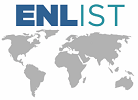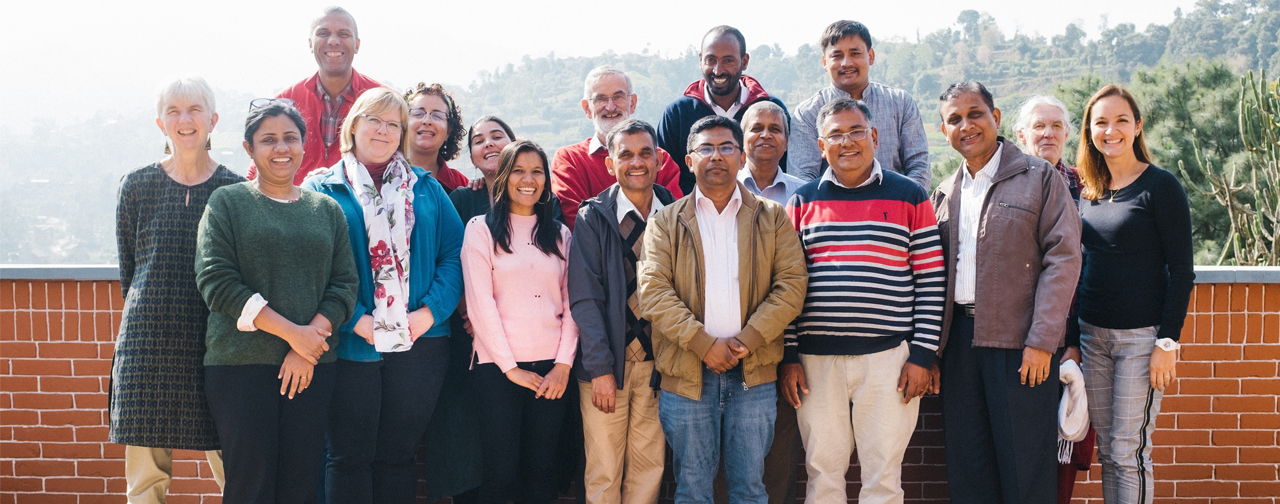
ENLIST Meeting in Kathmandu - November 2018
ENLIST
The Erythema Nodosum Leprosum International STudy (ENLIST) group is an international partnership between seven countries focused on improving the understanding and treatment of Erythema nodosum leprosum (ENL).
Leprosy remains a significant problem in many countries. Despite effective treatment of the infection many individuals will develop painful, inflammatory episodes with treatment raising many issues.
The ENLIST group consists of 8 institutes based across seven countries, on 4 continents, co-ordinated by LSHTM in London.
Recent updates
Events
Newsletter
Contact us
Clinical Research Department
Faculty of Infectious and Tropical Diseases
London School of Hygiene and Tropical Medicine
Keppel Street, London, WC1E 7HT
Leprosy is caused by the bacterium Mycobacterium leprae and remains a significant problem in many countries. The treatment of the infection requires multi drug therapy for 6 or 12 months which is very effective. However, despite treatment of the infection many individuals will develop painful, inflammatory episodes which may cause permanent damage to nerves and other organs, often causing permanent disability. This is known as Erythema nodosum leprosum (ENL) and can effect up to 40% of leprosy patients.
The treatment of ENL is usually with steroids which have many adverse effects when given for prolonged periods in the high doses required. Thalidomide, which is effective, is not widely available and is banned in many leprosy endemic countries. The ENLIST group aims to:
- Improve the understanding of the mechanisms which cause ENL
- Improve the evidence used to guide treatment decisions
- Improve access to effective treatments
We are conducting two double blind randomised clinical trials to determine if methotrexate (an immunosuppressant) improves the outcomes for individuals with these severe episodes of inflammation.
What is leprosy?
Leprosy is an infectious disease which has been around since biblical times. It is spread through contact with nose and mouth droplets of an infected and untreated person. The symptoms of leprosy include disfiguring skin sores, lumps and bumps as well as nerve damage in the arms and legs. This nerve damage can lead to loss of feeling in the hands and feet so sufferers do not feel pain when they are injured, leading to further possibilities of infection and damage.
Leprosy is now a curable disease. Treatment usually consists of two or more antibiotics (multi-drug therapy) over a course of 6-12 months. Anti-inflammatory drugs may also be taken to reduce the nerve pain and damage caused by leprosy.
Stigma associated with leprosy
There is a huge amount of stigma surrounding leprosy mostly due to a lack of understanding about how the disease is transmitted and due to the disfigurements it can cause. In many poor and developing countries it has long been believed that leprosy is inherited and punishment for past misdeeds. In the past many communities have shunned leprosy suffers, creating isolated colonies to quarantine patients.
Due to the stigma surrounding leprosy many sufferers delay seeking medical advice when symptoms appear. This can delay treatment and cause unnecessary suffering and deformities. There are now many organisations working around the globe to educate communities on the facts of leprosy and its treatment.
Recent updates
Events
Newsletter
Contact us
Clinical Research Department
Faculty of Infectious and Tropical Diseases
London School of Hygiene and Tropical Medicine
Keppel Street, London, WC1E 7HT
We are clinicians and laboratory scientists with extensive experience in the treatment and investigation of the causes of ENL. We are based at institutions in six countries on four continents. The group is coordinated from London and includes five centres in the two countries with highest rates of leprosy: India and Brazil.
The ENLIST group would benefit form support for the network, supporting work in India, promoting web based data collection, collecting data on severity, testing new anti-inflammatory drugs.
In addition to India and Brazil ENLIST members are also based in Bangladesh, Ethiopia, Nepal and the Philippines. We are hoping to recruit further centres in Indonesia and Mali in the near future.
Find more about the LSHTM team below:
Our funders
The ENLIST project receives funding from 3 different European organisations: the Leprosy Research Initiative (LRI), Hospital & Homes of St Giles and the Turing Foundation.

The Leprosy Research Initiative is a combined venture of ILEP members and closely associated partners, which was launched in 2013, with the preamble to establish a joint fund to support leprosy research and mechanisms to access external funding.
The Hospital & Homes of St. Giles charity
The Hospital and Homes of St Giles charity was started in 1914 to provide a place of respite for those who had contracted leprosy during service in the British Empire and for many years was run by sisters of the Community of the Sacred Passion as nurses. Numbers of both nuns and patients had declined by the late 1970s and the decision was taken to sell the site in East Hanningfield, Essex, to a housing association with an agreement that the residual patients could continue to live there and an amount of money. The Trustees of the Charity then decided to spend the income from the resulting investments on sponsoring research into leprosy and thus started a long term relationship with the London School of Hygiene and Tropical Medicine. The assets of the charity have been declining over time in recognition of the need to maintain research spending but the Trustees are firmly of the view that spending on research is the best possible use of the Charity’s money.
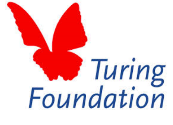
The Turing Foundation was founded in July 2006 by Pieter and Françoise Geelen. The name of the foundation honours Alan Turing (1912-1954), the British scientist who is regarded by many as the founder of modern computer science. Turing has always been one of the heroes of Pieter Geelen. When Geelen and a friend who studied computer science together started a company in 1991, they named it the Turing Machine Company. In 2005 this company was renamed TomTom and it was listed on the Dutch stock exchange. From the proceeds of that IPO, Pieter and Françoise Geelen started the Turing Foundation. Upon the formation, Pieter and Françoise Geelen chose four objectives for the foundation’s funding strategy: education, art, nature conservation and leprosy research.
Recent updates
Events
Newsletter
Contact us
Clinical Research Department
Faculty of Infectious and Tropical Diseases
London School of Hygiene and Tropical Medicine
Keppel Street, London, WC1E 7HT
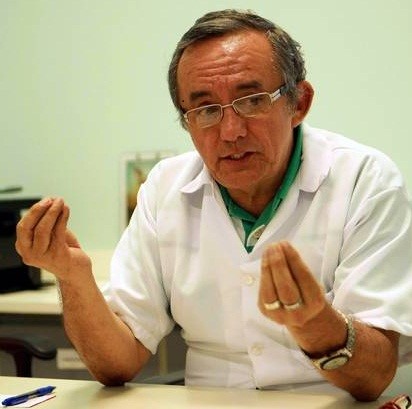
Dr. Jose Augusto da Costa Nery
FIOCRUZ - Rio de Janeiro, Brazil
Associate Researcher in Public Health of the Leprosy Laboratory (LAHAN) of the Oswaldo Cruz Institute, Oswaldo Cruz Foundation - FIOCRUZ, Rio de Janeiro. He has a PhD in Medicine (Infectious and Parasitic Diseases - DIP) from the Federal University of Rio de Janeiro - UFF (1995) and a PhD in Medicine (Infectious and Parasitic Diseases - DIP) UFRJ (2000). Professor of Dermatology at the Estácio de Sá University and the Institute of Dermatology Prof. Rubem David Azulay of the Santa Casa da Misericórdia in Rio de Janeiro. Professional with experience in clinical and therapeutic research, with emphasis on infectious diseases, acting mainly in the following pathologies: Leprosy; Sexually Transmitted Diseases and HIV.
For more information:
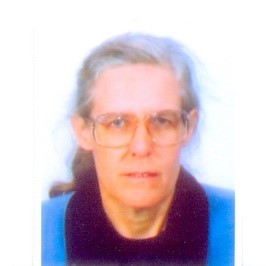
C Ruth Butlin CBE, MA, MB BCh
DBLM Hospital Program, The Leprosy Mission International -Bangladesh
Current Designation: Honorary Medical advisor to DBLM hospital & Rural Health Programme, of The Leprosy Mission International, Bangladesh.
Past experience: over 30 years working in leprosy in 3 countries (India, Nepal, Bangladesh)
Areas of special interest: preventing and managing disability, teaching and training of health workers for comprehensive management of leprosy.
Publications: author/co-authorship of many papers and conference presentations on subjects related to leprosy, including drug resistance, clinical aspects, disease control, chemotherapy, disability and assessment of reactions.
Member of Editorial Board of The Leprosy Review.
Member of ENLIST consortium since 2014.
Special awards: CBE in Birthday honours list 2001.
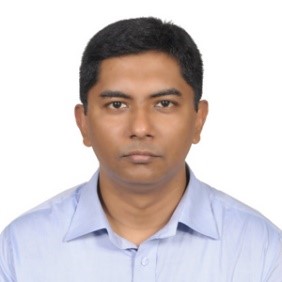
Dr. Benjamin Jewel Rozario
DBLM Hospital Program, The Leprosy Mission International -Bangladesh
Residential Medical Officer, DBLM Hospital Program, The Leprosy Mission International -Bangladesh.
Responsible for medical care and medical services of DBLM Hospital including surgery, and with the team of staff work towards holistic care of people affected by leprosy or other disabilities. Responsible for supervising all medical, surgical and disability services, providing necessary supervision for physiotherapy technicians and assistive device section, laboratory and nursing department and responsible for usage of budget. Also responsible for facilitating good understanding and smooth cooperation between all different persons involved in the project and other relevant stakeholders, including local officials in health and civil administration, and other NGOs who refer patients to DBLM Hospital.

Marivic F. Balagon , M.D.
Leonard Wood Memorial for the Eradication of Leprosy (later American Leprosy Foundation) - The Philippines
Executive Director
Leonard Wood Memorial
Center for TB and Leprosy Research
https://www.leprosy.org/leonard-wood-memorial/
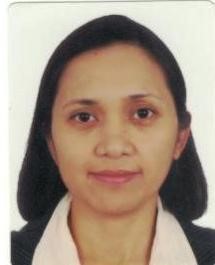
Armi A. Maghanoy, M.D.
Leonard Wood Memorial for the Eradication of Leprosy (later American Leprosy Foundation) - The Philippines
Chief, Epidemiology Branch
Leonard Wood Memorial
Center for TB and Leprosy Researc
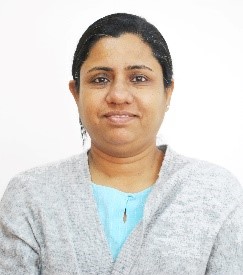
Dr. Joydeepa Darlong
The leprosy Mission Trust India - Delhi, India
Experienced leprologist with a demonstrated history of working in the non-profit organization management industry. Skilled in Non-profit Organizations, Epidemiology, Research, Fundraising, Monitoring evaluation, quality assurance and infectious diseases and International Health.
The Leprosy Mission Trust India
Dr Shimelis Doni
ALERT Hospital - Addis Ababa, Ethiopia
Currently I am working as a clinician and head of Dermatology Department at ALERT Hospital.
Primary Affiliation: All African Leprosy and Dermatology Education and Training Center - Addis Ababa , 14 , Ethiopia
Specialties: Dermatovenereology
Research Interests: Leprosy, dermatology and seal transmitted infection
Dr. Saba Lambert
ALERT Hospital - Addis Ababa, Ethiopia
LSHTM - London UK (clinical research fellow)
Registered doctor with a licence to practice in Ethiopia. She has have worked in Ethiopia for 8 years, 6 of which were based at ALERT Hospital under a research project sponsored by the London School of Hygiene and Tropical Medicine, for which she obtained her PhD in 2015. During her time at ALERT, she worked with AHRI on various projects, was involved in teaching in the ALERT training centre on leprosy courses, was a founding member of the LEAG (Leprosy Expert Advisory Group) and was involved in many leprosy projects with the Ministry of Health (Leprosy Mapping and Leprosy Referral Centres Assessment and Strengthening). She has presented the ALERT work at many international conferences. She has a passion for her work in Leprosy and especially for ALERT.

Dr. Deanna Hagge, Ph.D.
The Leprosy Mission Nepal - Anandaban Hospital, Nepal
Research Scientist, Nepal. She is the Research Director of the Mycobacterial Research Laboratories (MRL) at Anandaban, a tertiary leprosy referral hospital in Kathmandu, Nepal where she has worked since 2007. Previously, she spent a decade in leprosy laboratory research with the Molecular Biology and Immunology Departments of the U.S. Department of Health and Human Services National Hansen’s Disease Programs. She acts as the onsite coordinator for several international collaborative research projects as well as primary clinical and laboratory studies. Leprosy research areas include: clinical trials, immunological complications, drug resistance, medical chart reviews, patient surveys, diagnostics, neuropathy, genetic susceptibility, transmission and helminth co-infections.

Dr. M. Yulianto Listiawan, Sp.KK(K), FINSDV, FAADV
Dr Soetomo General Hospital- Surabaya, Indonesia
Dermatovenereologist Consultant and Vice President in Education & Profession of The Indonesian Society of Dermatology and Venereology. Chairman of Indonesia Aesthetic Laser Study
http://rsudrsoetomo.jatimprov.go.id/2017/

Dr. Medhi Denisa Alinda
Dr. Soetomo General Hospital- Surabaya, Indonesia
Dermatologist from Surabaya, Indonesia, who works in the Leprosy Division. She graduated from the Universitas Airlangga Medical Faculty in 2014, she was the youngest graduate. Dr. Medhi has been practising in the Department of Venereology Dr. Soetomo Hospital, one of the referral hospital in East Java. Her practice focuses on Leprosy at the Dr. Soetomo Hospital and the Tropical Disease Centre. She also often fills a charity event for leprosy patients and for general practitioners. Currently she has already been part in many research projects about leprosy.
Dr. Vivek V. Pai
Bombay Leprosy Project - Mumbai, India
Director - Bombay Leprosy Project
- Medical Officer in Bombay Leprosy Project for 1987 to 1993.
- Assistant Director in Bombay Leprosy Project since 1993 to March 1996.
- Dy Director in Bombay Leprosy Project April 1996 to 2004.
- Addl. Director in Bombay Leprosy Project since January 2004 and currently Director since February 2007 till date.
Recent updates
Events
Newsletter
Contact us
Clinical Research Department
Faculty of Infectious and Tropical Diseases
London School of Hygiene and Tropical Medicine
Keppel Street, London, WC1E 7HT
The ENLIST group regularly publishes in journals like the Leprosy Review and PLOS. Below is an overview of our publications.
Publications
An assessment of the reported impact of the COVID-19 pandemic on leprosy services using an online survey of practitioners in leprosy referral centres
Published Transactions of the Royal Society of Tropical Medicine and Hygiene in June 2021
Background: The coronavirus disease 2019 (COVID-19) pandemic has led to governments implementing a variety of public health measures to control transmission and has affected health services. Leprosy is a communicable neglected tropical disease caused by Mycobacterium leprae and is an important health problem in low- and middle-income countries. The natural history of leprosy means that affected individuals need long-term follow-up. The measures recommended to reduce transmission of severe acute respiratory syndrome coronavirus 2 (SARS-CoV-2) can create barriers to health services. We evaluated the impact of the COVID-19 epidemic response on leprosy services and disease management.
Methods: We conducted a cross-sectional online survey with healthcare professionals in leprosy referral centres.
Results: Eighty percent of leprosy diagnostic services were reduced. All respondents reported that multidrug therapy (MDT) was available but two reported a reduced stock. Clinicians used alternative strategies such as telephone consultations to maintain contact with patients. However, patients were not able to travel to the referral centres.
Discussion: This study highlights the effects of the initial phase of the SARS-CoV-2 pandemic on leprosy services in a range of leprosy-endemic countries. Many services remained open, providing leprosy diagnosis, MDT and leprosy reaction medications. Centres developed innovative measures to counter the negative impacts of the COVID-19 pandemic.
Keywords: COVID-19; health services; leprosy; leprosy referral centres; neglected tropical diseases; pandemic.
Methotrexate and prednisolone study in erythema nodosum leprosum (MaPs in ENL) protocol: a double-blind randomised clinical trial
Published BMJ Open November 2020
Introduction: Erythema nodosum leprosum (ENL) is an immunological complication of leprosy. ENL results in morbidity and disability and if it is not treated can lead to death. The current treatment consists of thalidomide or high doses of oral corticosteroids for prolonged periods. Thalidomide is not available in many leprosy endemic countries. The use of corticosteroids is associated with morbidity and mortality. Identifying treatment regimens that reduce the use of corticosteroids in ENL is essential. Methotrexate (MTX) is used to treat many inflammatory diseases and has been used successfully to treat patients with ENL not controlled by other drugs, including prednisolone and thalidomide. We present the protocol of the ‘MTX and prednisolone study in ENL’ (MaPs in ENL) a randomised controlled trial (RCT) designed to test the efficacy of MTX in the management of ENL.
Methods and analysis: MaPs in ENL is an international multicentre RCT, which will be conducted in leprosy referral centres in Bangladesh, Brazil, Ethiopia, India, Indonesia and Nepal. Patients diagnosed with ENL who consent to participate will be randomly allocated to receive 48 weeks of weekly oral MTX plus 20 weeks of prednisolone or 48 weeks of placebo plus 20 weeks of prednisolone. Participants will be stratified by type of ENL into those with acute ENL and those with chronic and recurrent ENL. The primary objective is to determine whether MTX reduces the requirement for additional prednisolone. Patients’ reported outcome measures will be used to assess the efficacy of MTX. Participants will be closely monitored for adverse events.
Ethics and dissemination: Results will be submitted for publication in peer-reviewed journals. Ethical approval was obtained from the Observational/Interventions Research Ethics Committee of the London School of Hygiene & Tropical Medicine (15762); The Leprosy Mission International Bangladesh Institutional Research Board (in process); AHRI-ALERT Ethical Review Committee, Ethiopia; Ethics Committee of the Managing Committee of the Bombay Leprosy Project; and The Leprosy Mission Trust India Ethics Committee; the Nepal Health and Research Council and Health Research Ethics Committee Dr. Soetomo, Indonesia. This study is registered at www.clinicaltrials.gov. This is the first RCT of MTX for ENL and will contribute to the evidence for the management of ENL.
Trial registration number: NCT 03775460.
A leprosy clinical severity scale for erythema nodosum leprosum: An international, multicentre validation study of the ENLIST ENL Severity Scale
Published PLOS - July 2017
Erythema nodosum leprosum (ENL) is a severe, painful complication of leprosy, which can occur before, during or after successful treatment of the infection. ENL is characterised by severe pain and the development of new painful skin lesions. Other organ systems are often affected. ENL may continue to affect people for many years leading to disability, significant loss of income and sometimes death. ENL often requires prolonged treatment with corticosteroids, thalidomide or other drugs that modulate the immune system. Thalidomide is the most effective treatment but is not widely available or affordable in many leprosy endemic settings. This results in many people taking high doses of corticosteroids for prolonged periods and being at risk of severe adverse effects. In order to assess the efficacy of different treatments for ENL it is important to be able to compare individuals before and after treatment. This is difficult to do in a complex, multi-system disorder such as ENL. To overcome this problem, we have developed a scale, which is easy to use, to measure the severity of ENL. In this article, we describe the validation of this scale, which ensures that it is a useful measure of ENL severity.
The development of a severity scale for Erythema Nodosum Leprosum—the ENLIST ENL severity scale
Published Leprosy Review - September 2016
Introduction: Erythema nodosum leprosum (ENL) is a severe, multi-system complication of leprosy which is difficult to manage. The evidence for effective treatment is limited and defining outcome measures for clinical trials is difficult. There are no validated measures of disease severity and so we wished to develop a clinical severity scale.
Methods: Three published scales that had been used in ENL research were applied to patients with ENL at six leprosy referral centres. An analysis of the clinical features associated with ENL severity was performed on data obtained from the ENLIST 1 study. A meeting of experienced leprosy researchers was held to incorporate the findings from the scale testing and data analysis into a clinical severity scale for ENL.
Results: None of the three scales used were found to be ideal but some features of each were incorporated into a new scale along with novel items felt to be appropriate. A final 16 item scale--the ENLIST ENL Severity Scale was agreed by the meeting participants and detailed notes and definitions developed. Conclusions: We have developed a new severity measure for ENL which we propose to subject to formal validation.
ENLIST 1: An International Multi-centre Cross-sectional Study of the Clinical Features of Erythema Nodosum Leprosum
Published PLOS - September 2015
Leprosy is caused by a bacterium and is curable with a combination of antibiotics known as multi-drug therapy, which patients take for six or 12 months. However, a significant proportion of leprosy patients experience severe inflammation in their skin, nerves and other organs known as erythema nodosum leprosum (ENL). ENL is a severe complication of leprosy which can occur before, during, or after completion of antibacterial treatment. ENL causes severe morbidity affecting not only the skin, but also bones, joints, eyes, nerves, testes and kidneys. ENL may be fatal and it has been shown that the adverse effects of corticosteroid treatment also contribute to mortality. An effective treatment for ENL is thalidomide but this is not available in many leprosy endemic countries or is severely constrained by availability, cost and justified concerns about teratogenicity. Thalidomide, despite its effectiveness, is rarely used as a first line agent. Other effective drugs need to be identified to reduce the burden of this condition. In order to establish which treatments will be effective in ENL it is necessary to have a clear picture of the clinical features of the disease and how these influence severity. This is the first systematic study of ENL to define these and will help in developing tools to facilitate treatment studies of this severe, debilitating complication of leprosy.
Recent updates
Events
Newsletter
Contact us
Clinical Research Department
Faculty of Infectious and Tropical Diseases
London School of Hygiene and Tropical Medicine
Keppel Street, London, WC1E 7HT
Research Degree Poster Day at LSHTM
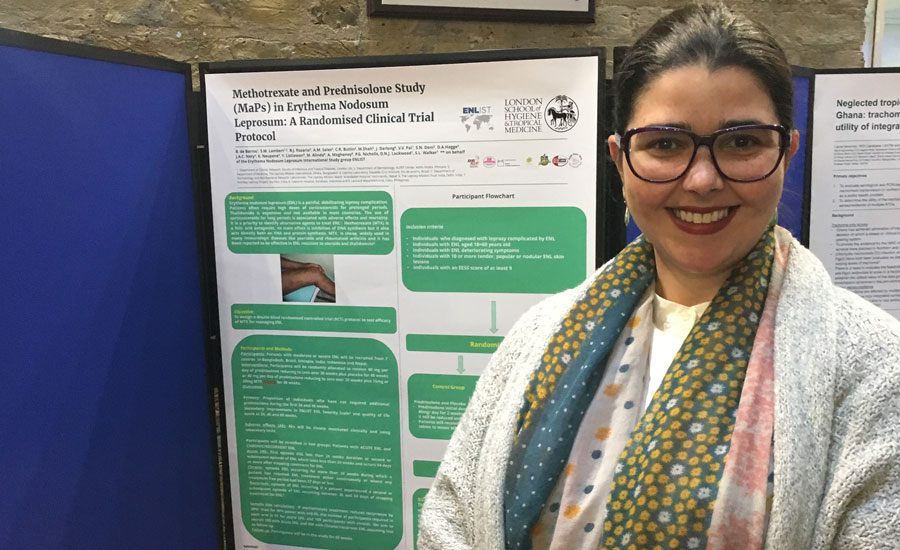
The Research Degrees Poster Day is an annual School-wide event, with students from each of the three faculties presenting posters on their research topic. All doctoral students are expected to present a poster at this event at least once during their course of studies.
Barbara De Barros presented her poster on the protocol currently being developed by ENLIST. This new study will evaluate the impact of using methotrexate in ENL treatment.
ENLIST meeting in Kathmandu - November 2018
The fifth ENLIST meeting was hosted by Dr. Deanna Hagge, Dr. Mahesh Shah and Dr. Indra Napit at the Ambassador Hotel and at Anandaban Hospital, Kathmandu, Nepal. The meeting took place on the 12th, 13th and 14th November 2018.
Collaborators from Bangladesh, Brazil, Ethiopia, India, Indonesia, Nepal and UK were present. The objectives of the meeting was to review the ENLIST –Methotrexate clinical trial protocol and start planning the start of the study. 2019 will be a very exciting year for the ENLIST group, all centres will start recruitment, which will take 2 years.
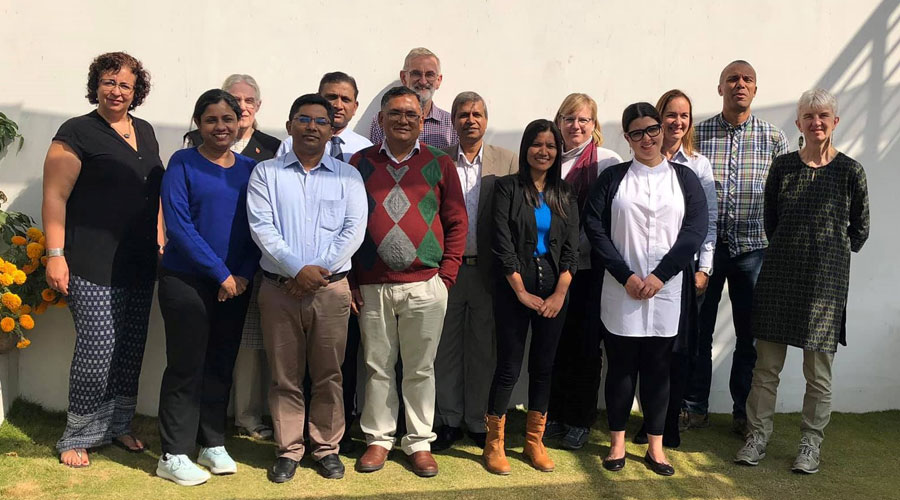
The 20th International Leprosy Congress - Manila, The Philippines
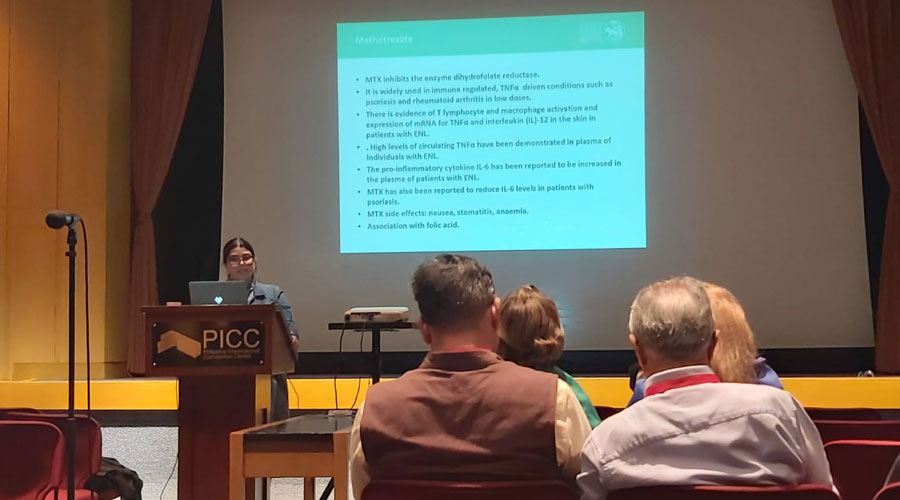
More than 1,000 delegates from 55 countries met in Manila to share research and experience on all facets of leprosy.
Our group and our partners presented in several sessions.
The International Leprosy Congress is a once-in-three-years ‘snapshot’ of the leprosy world. It was impressive to see people who had attended six, seven or even more Congresses over the years. But equally impressive, we saw large numbers of scientists and practitioners who are relatively new to the leprosy field, including 12% of delegates under 30 years of age. The overall theme was “Global partnership in addressing current challenges”. Many speakers referred to the Global Partnership for Zero Leprosy, which was formed as a direct outcome of the 2016 Congress, and more generally to the need to work together if we are to achieve the goal of zero leprosy.
LRI Online Spring meeting - 7 and 8 April 2022
ENLIST meeting - 8 November 2022, Hyderabad, India
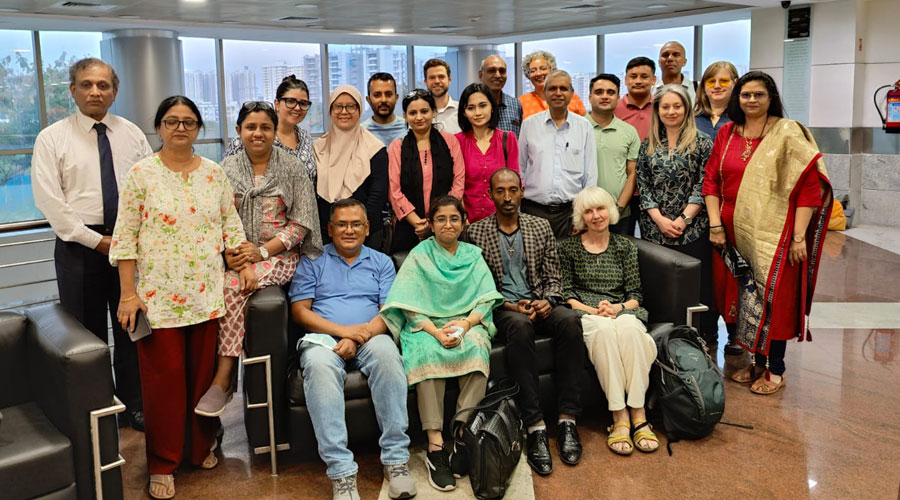
21th International Leprosy Congress - 8th-11th November 2022, Hyderabad, India
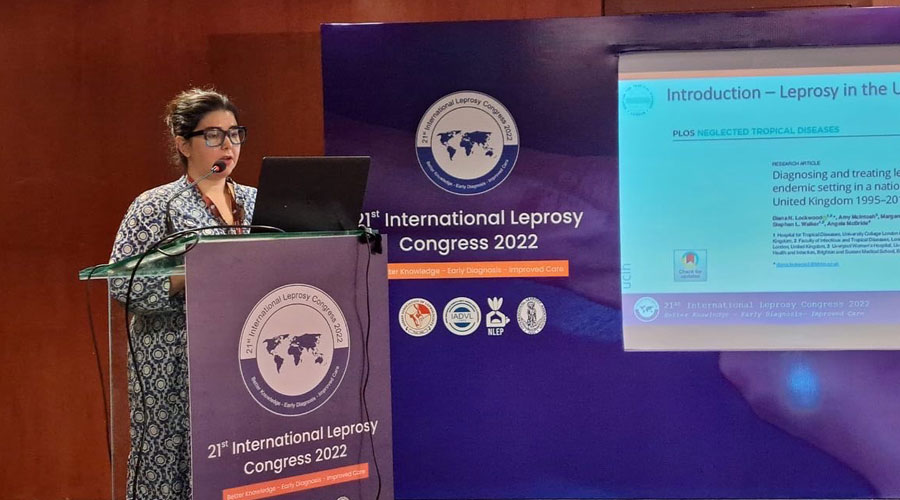
LRI Spring meeting - 20th and 21st April 2023
Upcoming Events
LRI Spring meeting 2024
International Leprosy Congress - 2025 to be confirmed
Recent updates
Events
Newsletter
Contact us
Clinical Research Department
Faculty of Infectious and Tropical Diseases
London School of Hygiene and Tropical Medicine
Keppel Street, London, WC1E 7HT
The ELIST group conceived, developed and implemented MaPs in ENL: Methotrexate and Prednisolone study in Erythema Nodosum Leprosum
MaPs in ENL is the largest clinical trial on ENL treatment to be conducted in six leprosy referral centres in five countries.
Find out more at MaPs website.
Recent updates
Events
Newsletter
Contact us
Clinical Research Department
Faculty of Infectious and Tropical Diseases
London School of Hygiene and Tropical Medicine
Keppel Street, London, WC1E 7HT
